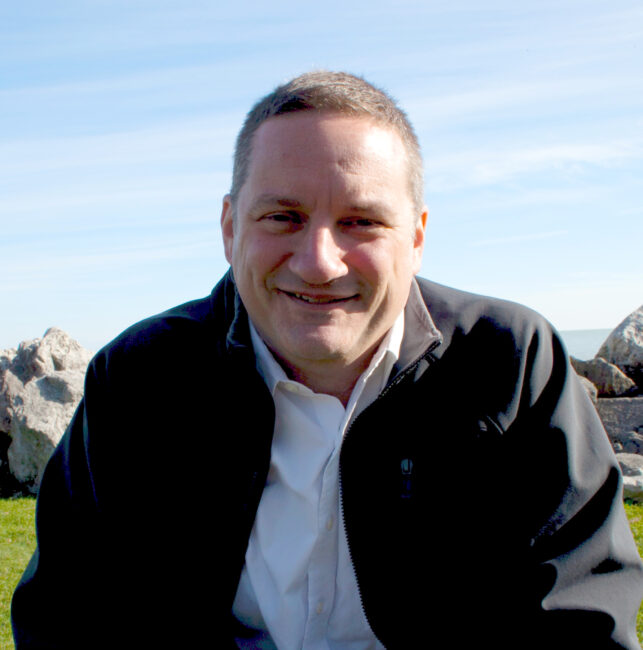Tim Frick is the CEO of Mightybytes. Tim is a thought leader, influencer, visionary, and successful entrepreneur. Tim provides the leadership and energy that has inspired the creation of Mightybytes. Tim Frick joins other leading CEOs and Founders taking part in our Leader Roundtable Interview Series. The DotCom Magazine editorial team has recently awarded Mightybytes with our Impact Company of 2019 award. We are delighted to have Tim join us for our Leader Roundtable Interview.

Tim, thank you so much for taking the time out of your busy day for this interview about your company, leadership, and entrepreneurship
1. Tim, please tell us about Mightybytes.
Mightybytes is a digital agency and Certified B Corp started in 1998. We’re one of the oldest independent digital agencies in Chicago. We blend strategy, design, and development with sustainability and marketing practices to help conscious companies, sustainable brands, and large nonprofits solve problems and get measurable results.
Good technology, human-centered design, and marketing practices offer powerful ways to change human behavior, shift attitudes, and generate awareness. We bring the brightest minds in these disciplines to the table for exploring potential solutions to problems. By also applying sustainability principles to everything we do, we offer better chances for long-term success.
2. How did you come up with the idea for Mightybytes?
Mightybytes was started with an intent to help mission-driven organizations use the internet to find success. It is my second company. In the 1990s, there were an awful lot of internet startups with a lot of awful ideas, many of which received massive amounts of funding. Meanwhile, nonprofits and mission-focused startups—organizations dedicated to creating a better future for us all—were being left behind. I wanted to help these organizations succeed.
Back then, the idea of purpose and profit were pretty much mutually exclusive. You either worked for a nonprofit to create change (often for less money) or you worked for a company where profit was the primary focus, often at the expense of stakeholders such as employees, communities, or the environment. Rarely could you do both in tandem. I have always believed that you could do well while also doing good in the world. This has been my primary business driver since becoming an entrepreneur in 1996.
3. What is the key to your company’s success?
We define success based on the positive social and environmental impact we can create in the world, not necessarily by how fast we’re growing, how many people we hire, etc. Of course, as a for-profit company dedicated to a triple bottom line of people, planet and prosperity, good margins are critical to funding our aspirations, so we make sure that smart financial planning and clear processes underscore all the work we do.
In 2011, we became a Certified B Corp. Certified B Corps use the power of business to build an inclusive and more sustainable economy. There are currently about 3,000 of these companies around the world, including brands you may recognize such as Ben & Jerry’s and Patagonia.
Certified B Corps use an objective, third-party assessment, the B Impact Assessment, to meet the highest verified standards of social and environmental performance, transparency, and accountability. This provides a blueprint for us to build a better company that is optimized for long-term success—not just next quarter’s returns. Our company, and all B Corps, have ethical principles in their DNA.
4. Many of our readers are just starting to build a company. What advice can you give entrepreneurs just starting out with a new venture?
The art form of entrepreneurship can be rewarding in many ways, but it’s not for everyone. Running a business requires a lot of grit and tenacity. It can also be very lonely. You must keep all the moving parts in sync with one another to ensure long-term solvency and success. Here are a few things to keep in mind:
- Put self-care first: This is critical, especially to new business owners. It can be tempting to work around the clock, seven days a week, chasing after the ‘next big deal’. This is the fast track to emotional and physical burnout. I’ve had firsthand experience with this. Plus, stepping away from your business often means you’ll return to a vexing problem with a fresh perspective. This can lead to better solutions. Give yourself the space and time necessary to do your best work.
- Fall in love with your problems: Many entrepreneurs fall in love with the solutions they devise and end up missing the mark when trying to solve actual customer problems. Don’t do this. Stay laser-focused on solving customer problems. When it comes to evolving products or services, identify ‘safe-to-try’ experiments that minimize risk while embracing innovation. Do more of what works, less of what doesn’t.
- Lead with empathy: Allow your team to do their best work by giving them space and freedom to make occasional mistakes. Make sure they know you’re available to answer any questions or provide direction, but don’t be a helicopter boss.
- Embrace accountability: This is the 800 pound gorilla when it comes to running a business. A business without accountability won’t be around very long. Hold your stakeholders accountable to their commitments, including yourself. This means having difficult conversations with suppliers or employees when necessary. There’s a difference between occasional mistakes and poor performance.
5. For other entrepreneurs seeking to build a business as successful as yours, what advice can you give them when times get a little challenging?
All companies see their fair share of tough times. As a business owner, you absolutely must prepare for this because it will happen to you eventually. Here are some things to consider:
- Develop a tough skin: Everyone has opinions about how you should run your company. This is especially true when things get challenging. Try to build support from your team and other stakeholders rather than going it alone. Embrace criticism or input from others, but act only on those suggestions that make most sense to you. Don’t get too emotionally involved or spread the company thin trying to act on everyone’s advice. This is often easier said than done, but as a leader you must find a balance between stakeholder needs and what’s best for the business. In the end, if you’re a primary shareholder, the responsibility for financial risk falls on your shoulders. You have to make the tough calls.
- Build a support network: Good mentorship from experienced leaders can be incredibly valuable to maintain company success over time. Create an advisory committee, board of directors, or even a breakfast group comprised of other business leaders who can help you with challenging problems. Pay it forward once you have amassed experience of your own.
- Make tough decisions quickly: It can be tempting to wait things out and see if they improve. This can have dire financial consequences to your business, however. Reducing pay, letting people go, or changing suppliers is never easy, but the ramifications of not doing so in a timely manner can be devastating. You must run a tight financial ship above all else.
6. How do you make sure your customers will become raving fans of your company?
Collaboration and consensus-building are at the heart of our process. By designing solutions together and testing them early with users, we are much more likely to achieve shared success. Everyone wins. We make every attempt to provide long-term value to our clients. As a Certified B Corp, we also define value differently than traditional agencies: we look for opportunities to help clients and other stakeholders find success and achieve their missions, which in turn helps us achieve ours.
This value isn’t always monetary in nature. Our partnerships often rely on more than just an exchange of goods and services. Instead, we share resources and exchange ideas. We build community through educational events and useful content. We co-present at conferences with our clients. We provide referrals. And when we disagree, we work through problems together in the name of a shared goal.
Finally, we always strive to provide top-level service and are very gracious to clients who choose to work with us. We know they have many options when it comes to agency vendors. We’re grateful that they chose Mightybytes and always try to show that in the work we do for them.
7. In today’s fast changing business environment, how do you stay abreast of things?
I dedicate time in my daily calendar for research, writing, reading, and strategy. Not all of these things happen every day, but it is important to identify industry trends, shifts in customer needs, new technologies that could change how we operate, groundbreaking ideas, and so on. As a researcher and writer, I collect these ideas, identifying common patterns and new concepts that shape my writing and, eventually, company practices. I then generate rough outlines and share them with our team and others to beat up, hone, and improve.
This collaborative process has resulted in four books, countless blog posts, numerous guest articles, dozens of workshops and conference talks, and improved processes or new services at Mightybytes. It grows the company’s intellectual capital and drives sales while also feeding into our goal noted above to educate clients and help them find success. Since writing is a personal passion of mine, it also supports my need for self-care and balance as well.
8. What is your “Why”? Why do you get up in the morning, and how do you keep yourself at peak performance to lead Mightybytes?
We have an unprecedented number of problems in the world, from rampant inequality to an environmental emergency that will do us all in if we don’t act immediately. Business is the most powerful human-made force on the planet. It can play a monumental role in solving these problems. I strive every day to make Mightybytes the best example possible of how companies can align purpose with profit to solve social and environmental problems while also being prosperous.
In terms of peak performance, running a small business looks very different in your fifties than it does in your twenties, thirties, or even forties. I work hard to stay in good mental and physical shape. As mentioned above, I read a lot. I take hikes in nature whenever possible. I’m an avid cyclist. I work out regularly and eat a mostly plant-based diet. Each year, I do Climate Ride, a multi-day endurance cycling event that raises money for environmental charities, some of which are Mightybytes clients. This year’s event is through Glacier National Park, one of the only remaining places in continental U.S. where you can still see glaciers, though they are shrinking rapidly.
At the office, we’re committed to maintaining work-life balance and transparency about company performance. Stakeholder input is always encouraged. This helps everyone stay on the same page about where we’re headed and how we’ll get there. Keeping the team small and nimble helps too.
9. Can you recommend a book that has had an influence in your career? How did it influence you?
I read whenever I can, which makes it hard to choose just one book to recommend. I recently read Lean Impact: How to Innovate Radically for Greater Social Good by Ann Mei Chang. She talks about how social enterprises can use Lean Startup principles to maximize desired outcomes on projects. While the book is specific to social impact projects, its concepts are applicable to any purpose-driven business as well. She includes an entire section on B Corps and other forms of social enterprise.
We use lean/agile concepts in our work whenever possible. They help us reduce waste, validate ideas, and stay focused on things that matter to achieve success. While this is a bit different and more flexible than a traditional approach, especially when it comes to philanthropy-driven projects, the results are far superior and help us create that long-term value for clients that I mentioned above.
10. What makes a great leader?
This is a relative question. While there are common attributes among all leaders, each company has its own unique set of challenges which require equally unique skills to address them. What might work well for my service-based agency, for instance, may not fly at a large consumer product manufacturer.
That said, all great leaders must have the right blend of humility, empathy, and confidence. They must be able to communicate a clear company vision and chart a course for achieving goals while also being open to different perspectives. They should also be willing to pivot any aspect of their company when the data tells them it is necessary to do so.
Great leaders also need great teams to succeed, and vice-versa. You can be the most inspiring leader in the world, but if you don’t have the right team to support your efforts, failure is inevitable. It may not come tomorrow, next month, or even next year, but teams and leaders that are out of sync spell eventual disaster for any company. When synced up, they can collectively lead a company to new heights and shared success.
Those who aspire to lead purpose-driven companies have twice the challenge of traditional entrepreneurs. Balancing purpose and profit requires a teamwide level of financial and operational literacy that not everyone is cut out for. In traditional companies, business decisions typically err on the side of profit. In purpose-driven companies, leaders must consider financial ramifications of any decision as well as the potential impact on stakeholders. It’s a delicate balancing act, but when it works, the rewards are well worth the effort.

Tim Frick, thank you so much for participating in the DotCom Magazine Leader Roundtable Interview Series. We very much appreciate the time you spent helping our readers learn more about what it takes to build a great company and become a great leader. We wish you, your family, and of course Mightybytes, nothing but the best.
Thanks again!






















